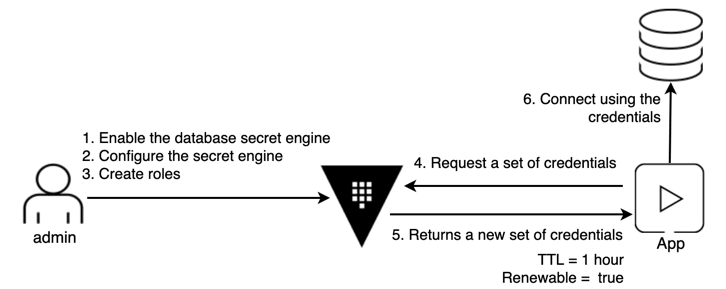
shiyuhang0
Posted on January 17, 2023

Hashicorp Vault can be used to manage database access.
As a MySQL-compatible Database. TiDB Cloud Serverless Tier can use the MySQL database Secrets Engine as a plugin to generate database credentials dynamically.
The following figure shows the workflow of using Vault's Dynamic Secrets. This article will demonstrate how to implement the workflow with TiDB Cloud.
Prerequest
- Create a serverless tier on TiDB Cloud console
- Install Vault
Starting the Server
Start a Vault server in development mode (dev server) with root as the root token
vault server -dev -dev-root-token-id root
Launch a new terminal session and set environment variables:
export VAULT_ADDR='http://127.0.0.1:8200'
Verify the Server is Running:
➜ ~ vault status
Key Value
--- -----
Seal Type shamir
Initialized true
Sealed false
Total Shares 1
Threshold 1
Version 1.12.2
Build Date 2022-11-23T12:53:46Z
Storage Type inmem
Cluster Name vault-cluster-7368793c
Cluster ID d892d1b1-f975-8bbb-cc73-369d1f48f3ad
HA Enabled false
Configure secrets engine (admin role)
Launch a new terminal session and perform the admin role.
Export an environment variable to authenticate with the root token:
export VAULT_ADDR='http://127.0.0.1:8200'
export VAULT_TOKEN=root
Enable the database secrets engine:
vault secrets enable database
Configure Vault with the following command:
vault write database/config/my-tidb-database \
plugin_name=mysql-database-plugin \
connection_url="{{username}}:{{password}}@tcp(gateway01.us-east-1.prod.aws.tidbcloud.com:4000)/" \
allowed_roles="readonly" \
username="8kwxfAybggzi***.root" \
password="***"\
username_template="8kwxfAybggzi***.{{.RoleName | truncate 8}}_{{random 7}}" \
tls_ca=@/etc/ssl/cert.pem
- A templated
connection_urlis required when using root credential rotation. - An
username_templateis required because Serverless Tier's username must be started with 8kwxfAybggzi*** and no longer than 32. You can adjust it according to Vault official doc. - a
tls_cais required because Serverless Tier must be connected with TLS. You need to change the path according to your OS, here is a reference
Configure a role that maps a name in Vault to an SQL statement to execute to create the database credential. I create a user and grant SELECT privileges for read-only.
vault write database/roles/readonly \
db_name=my-tidb-database \
creation_statements="CREATE USER '{{name}}'@'%' IDENTIFIED BY '{{password}}';GRANT SELECT ON *.* TO '{{name}}'@'%';" \
revocation_statements="DROP USER '{{name}}'@'%'; " \
default_ttl="1h" \
max_ttl="24h"
Create a readonly token (admin role)
Now, we need to create a token with a suitable policy for our customers.
create a readonly policy
➜ ~ vim readonly.hcl
# Get credentials from the database secrets engine 'readonly' role.
path "database/creds/readonly" {
capabilities = [ "read" ]
}
write the policy:
vault policy write readonly-policy readonly.hcl
create a token with the policy
➜ ~ vault token create -policy=readonly-policy
Key Value
--- -----
token hvs.CAESIOMvEUz3UuoUyp_nv5YV5KdyzeSnowZp_UoBAzDh64VdGh4KHGh2cy5FNllaUWFRN1I4VnBNdDAyZFNjTkI1U0Q
token_accessor 4CZMNFZ8PNKUPsLZFQJ2dXvQ
token_duration 768h
token_renewable true
token_policies ["default" "readonly-policy"]
identity_policies []
policies ["default" "readonly-policy"]
Now, the admin can control the permission by giving the readonly token.
Use dynamic secrets (app role)
Launch a new terminal session and perform the app role.
Export an environment variable to authenticate with the readonly token:
export VAULT_ADDR='http://127.0.0.1:8200'
export VAULT_TOKEN=hvs.CAESIOMvEUz3UuoUyp_nv5YV5KdyzeSnowZp_UoBAzDh64VdGh4KHGh2cy5FNllaUWFRN1I4VnBNdDAyZFNjTkI1U0Q
Generate a new credential by reading from the /creds endpoint with the readonly role:
➜ ~ vault read database/creds/readonly
Key Value
--- -----
lease_id database/creds/readonly/3PNLHrgWyoRLg5QVWblDFiPP
lease_duration 1h
lease_renewable true
password DTuVZ-rvWlbMVG8ST***
username 8kwxfAybggzi***.readonly_MVmoAos
Now, you can use the password and username to connect to TiDB Cloud. And it will only have read permission.
Other operators such as creating a role or reading with another role will be denied.
➜ ~ vault write database/roles/readonly2 \
db_name=my-tidb-database \
creation_statements="CREATE USER '{{name}}'@'%' IDENTIFIED BY '{{password}}';GRANT SELECT ON *.* TO '{{name}}'@'%';" \
default_ttl="1h" \
max_ttl="24h"
Error writing data to database/roles/readonly2: Error making API request.
URL: PUT http://127.0.0.1:8200/v1/database/roles/readonly2
Code: 403. Errors:
* 1 error occurred:
* permission denied
using root token to create a writeonly role:
vault write database/roles/writeonly \
db_name=my-tidb-database \
creation_statements="CREATE USER '{{name}}'@'%' IDENTIFIED BY '{{password}}';GRANT INSERT ON *.* TO '{{name}}'@'%';" \
revocation_statements="DROP USER '{{name}}'@'%'; " \
default_ttl="2m" \
max_ttl="24h"
using readonly token to read the writeonly role:
➜ ~ vault read database/creds/writeonly
Error reading database/creds/writeonly: Error making API request.
URL: GET http://127.0.0.1:8200/v1/database/creds/writeonly
Code: 403. Errors:
* 1 error occurred:
* permission denied
About the leases
The credential generated with the readonly role will expire after the 1h because readonly role's default_ttl is 1h.
For admin role:
- One way to avoid the expiration of credential is to delete the
revocation_statementswhen admin creates the readonly role. - admin can revoke the credential at any time.
- admin can renew the credential before it expires. But can't renew more than readonly role's
max_ttl.
For app role:
- app role can ask for the renew permission from admin. Then app role can renew the credential.
- Once the credential expires, app role needs to generate a new credential with the readonly token by
vault read database/creds/readonlycommand. For example, use a cron job to reload the credential for each ttl.
Prospect
- You can also try out TiDB Cloud Dedicated tier with Vault on the similar workflow.
- TiDB Cloud Serverless tier may modify the mechanism of user management in the future. We may also provide a TiDB Cloud plugin in that time. Thus, this doc may not always work.

Posted on January 17, 2023
Join Our Newsletter. No Spam, Only the good stuff.
Sign up to receive the latest update from our blog.
